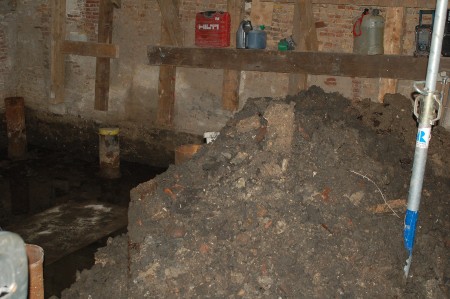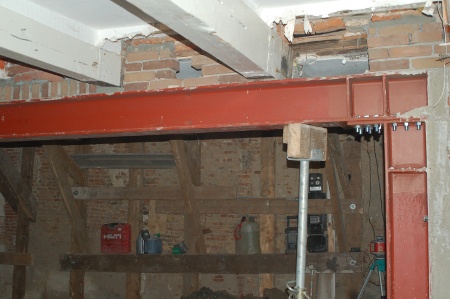It’s been a while since I’ve posted anything about my house foundation, with all the excitement of the events in Brussels, I almost stopped paying attention. They’ve just gotten to the exciting part! They’re removing the contaminated ground under the house.
Since the house is built nearly at water level, they didn’t have to dig far before they reached water. In the picture above you can see they inserted a measuring stick so they could monitor the water level with respect to the dirt. Soon they are going to start running a pump to remove some of the water, so they can dig deeper. Rain is forecast, so the water table might start rising too.
You can see the pipes sticking out of the ground are what they drove for the piles. They aren’t yet filled with concrete, but that’s due to happen on Monday.
The smell is quite incredible. Oily and very dirty smelling. It’s classified by the city as very toxic waste (when compared to what they usually find under peoples houses in the city). Mostly it’s heavy metals that are the problem; high levels of zinc, a bit of lead and mercury, and some other things. The test showed traces of petroleum distillates. It’s very dirty!
According to city records, until 1930 or so the house had a dirt floor. What they found was 3 different concrete floors built on top of one another.
The house is 350 years old and and been sinking the whole time. Literally, from one generation to the next, they’ve just been dumping their crap into the floor, letting it sink and building a new floor on top.
Here you can see the former load bearing wall I posted about before. Now it’s a nice new steel beam.





What was happening in your house to cause the pollution? It sounds like something industrial; lead, mercury and zinc ores are found together, so could it be on the site of a foundry?
Hi Robert,
Searching around on Google for zinc contamination especially suggested indeed there was some metal smelting going on. I know next door at one point they sold petroleum products like kerosene and maybe others, and my neighbor had much higher levels of this kind of stuff in his ground than me.
I think most of the detailed information about this house was lost during WWII, but in general I know this neighborhood is where they relocated all the ‘dirty’ businesses, that other neighborhoods didn’t want. That including tanning and rope making, and probably foundry and blacksmithing too.
For a while they required a complete decontamination of every piece of ground in the city before anything new was built on it, but now they’ve decided it was just too expensive considering the outcome. It generally meant first digging, then putting in pipes to run water through it, and in total could take a year or more.
Now they just require us to do a bit of digging, then backfill with sand and pretend it’s clean. It will be an improvement, that’s for sure, but far from complete decontamination.
” high levels of zinc, a bit of lead and mercury, and some other things”
Just the kind of things you find in the ground in any north european town. Linseed oil paint traditionally contained pigment with zinc, lead and other metals, we nowaday think of as poison.
When the wood was painted, the paint slowly disintegrated, was repainted, disintegrated…and all the old paint would fall to the ground to be recognized in our time as dangerous heavy metals.
Wonder what our time are leaving for the future?
So in other words your house is a little island in the sea! Are here any sharks in that water?
If there are any sharks down there, they probably look like this:
http://www.treehugger.com/blinky-the-fish-simpsons.jpg
Haha!
I’m wondering whether your neighbours are also having to go through a decontamination process like this… otherwise what’s to stop the leaching of chemicals from their properties back into yours after all this work is finished?
Mike,
I think this was part of the reason the city changed it’s policies in recent years.
When they required more extensive cleaning, it was very expensive and took a long time, then the result was a clean postage stamp sized plot in the middle of the city, with no hope of staying uncontaminated.
Also, the logistics of cleaning a piece of ground that lies under the water table are very complex. They have to insert corrugated steel along the sides to keep the surrounding water out, then pump the water out of the area being cleaned. Then what they dig is wet anyway, and has to be mixed with clean sand to some extent, to absorb the extra moisture and prevent the contamination from spreading as they transport it to a landfill. The sand just adds to the bulk, and means more has to go into the landfill.
The water they pump out is contaminated, but they just send that out to sea (who cares right?).
It’s just a big mess all the way around, and there are no real solutions. Like Søren said, it makes you wonder what we are leaving for the next generation. How are they going to get all the plastic out of the seas for example?